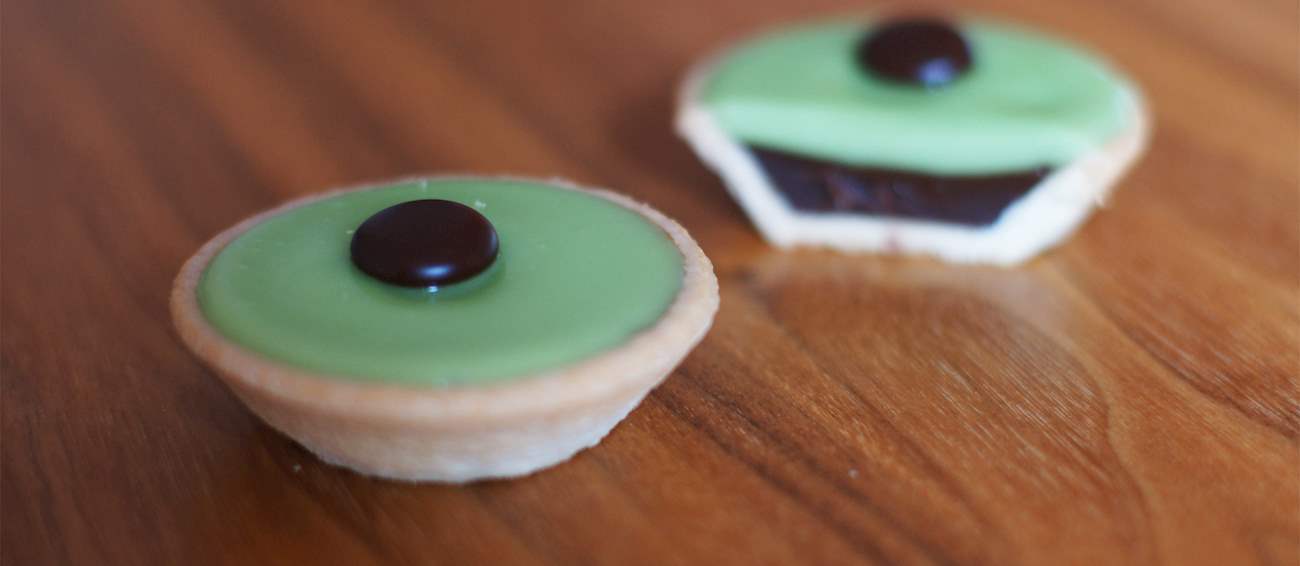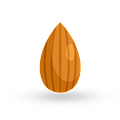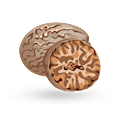This tart with a long tradition originates from the town of Imotski, and consists of a shortcrust pastry base and a flavorful almond filling. Both are heavily seasoned with various spices and different types of alcohol, from prošek or white wine in the pastry to maraschino cherry liqueur used in the filling.
Another important element of this cake is the elaborate woven lattice top which is typically studded with whole almonds.
Carac is a small Swiss pastry prepared with shortbread pie crust, chocolate, cream, and green icing. It is especially popular in the French part of the country. Even though most of these pastries are prepared in smaller sizes, they can also be enlarged for festive events and gatherings, when they are served sliced, just like regular pies or cakes.
The origin of carac is still quite murky, but it is known that the pastry was available in the early 20th century, while the name carac is phonetically linked to caraque, referring to a type of cocoa of high quality.
MAIN INGREDIENTS
One of the most famous Belgian desserts, this sweet and spicy, tart-shaped filled pastry is prepared exclusively in the Flemish town of Lier. The delectable Liers vlaaike consists of thin, pâté brisée crust filled with a thick, creamy purée—the base is a typical, unsweetened shortbread pie crust, while the aromatic filling consists of coarse breadcrumbs, candy syrup, milk, and flour.
However, the spicy flavor of vlaaike tarts comes from a secret combination of spices including cinnamon, cloves, nutmeg, and coriander. The original recipe is believed to be more than 300 years old, which makes Liers vlaaike one of the oldest baked goods from the province of Antwerp.
Originating from Graubünden in Switzerland, this dish is a traditional tart consisting of a shortbread pastry filled with nuts and caramel. Walnuts are typically used for the filling, but other nuts may also be used, although very rarely. The oldest known recipe dates back to 1900, and in 1934, a confectioner named Fausto Pult presented the cake to the public at the Swiss Sample Fair in Basel.
Nowadays, the cake is usually served cut into slices and paired with coffee or tea on the side.
Wähe is a delicious Swiss tart made in sweet and savory versions. The sweet version is prepared with seasonal fruits such as plums, apricots, rhubarb, and apples, while the savory ones typically include cheese, spinach, or onions, similar to the French quiche.
It is believed that the first versions of wähe were baked at home with leftover bread dough. Even though wähe was considered a poor man’s meal in the past, over time, the dish became popular with the middle class and was often consumed during fasting or on Fridays.
Named after the Austrian city of Linz, Linzertorte is a short cake with a crumbly, buttery pastry shell that is accentuated by lemon juice, cinnamon, and either almonds, walnuts, or hazelnuts. It's also the oldest cake named after a city. This sweet delicacy is ideally filled with redcurrant jam, but it can be replaced by raspberry or apricot jam.
On the top of the cake is a lattice crust, carefully arranged in a criss-cross design, giving it a unique visual appearance. The cake can be traced back to 1696, according to Jindrak, an Austrian confectioner famous for their Linzertorte, but whoever named the recipe or invented the cake will remain a mystery.
TasteAtlas food rankings are based on the ratings of the TasteAtlas audience, with a series of mechanisms that recognize real users and that ignore bot, nationalist or local patriotic ratings, and give additional value to the ratings of users that the system recognizes as knowledgeable. TasteAtlas Rankings should not be seen as the final global conclusion about food. Their purpose is to promote excellent local foods, instill pride in traditional dishes, and arouse curiosity about dishes you haven’t tried.













